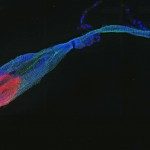Link to Pubmed [PMID] – 22990786
Methods Mol. Biol. 2013;923:291-7
The altered deformability of erythrocytes infected with Plasmodium falciparum is central in malaria -pathogenesis, as it influences the hemodynamic properties of the infected cell and its retention in the spleen. Exported parasite proteins, as well as the shape and volume of the parasite itself, influence the deformability of the infected erythrocyte. To explore changes in erythrocyte deformability, we have developed a new method, called microsphiltration, based on filtration of erythrocytes through a mixture of metal microspheres that mimic the geometry of inter-endothelial splenic slits. As P. falciparum develops in its host cell, the retention rates observed in microspheres correlate with the progressive decrease of erythrocyte deformability and with the retention rates in the spleen. The yields of microsphiltration separation allow for molecular analyses of subpopulations with distinct mechanical phenotypes.

